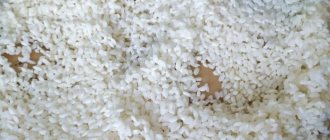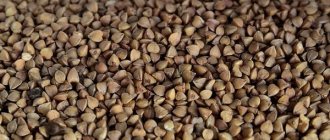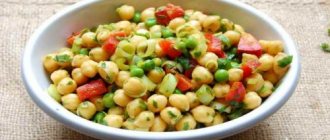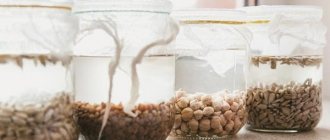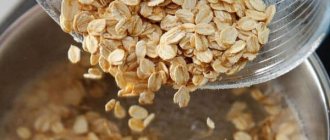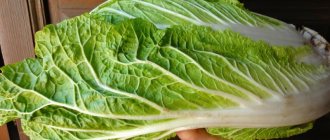The pea group is one of the most popular all over the world, because it is cheap compared to other varieties of legumes, and many different dishes can be prepared from it. The secret of success is proper soaking before cooking, after which the peas acquire the desired softness or quickly become pureed. It is no coincidence that it can be found so often in dishes of Russian, Oriental, Mediterranean or South American cuisine.
Purpose of the procedure
Before cooking, peas are always washed several times in clean water - this removes starch, dust and dirt. Before this, you need to sort it out, eliminating spoiled and rotten peas. However, the need to soak hard peas is still questionable. Some chefs believe that this action is necessary, others believe that it is a waste of time.
Pros include things like reducing cooking time and preventing bloating. It is still better to soak whole peas, because such a product, regardless of the manufacturer and the condition of the fruit, cooks for more than two hours, and its pre-treatment will shorten this period. As for split peas, they cook for three quarters of an hour, which is not an overly long period of time, so you can do without soaking.
The main purpose of soaking is to control the cooking time of the peas. If you immediately add it to the soup, then other vegetables may overcook and become soft, and the peas will never reach readiness. And vice versa - the meat may not reach the desired consistency and remain tough, and the peas will already become porridge.
With water added while boiling
Despite the simplicity of this method, it really works and allows you to bring the peas to full readiness in a minimum amount of time without the need to use anything special.
Required Products:
- two glasses of peas;
- the right amount of water;
- salt to taste;
- half a glass of cold water.
Cooking process:
- We wash the peas, put them in a saucepan and fill them with water. It should be twice as much as the product.
- Add salt and spices as desired.
- We wait until the contents come to a boil and after 10 minutes pour in the specified amount of cold water. After this, the mass will become soft within five minutes.
How to soak peas overnight?
Prolonged soaking may spoil the product. It is not difficult to determine that peas are overcooked: a kind of foam will appear on the surface of the water. This effect indicates that the beans have soured during soaking, and this can spoil the taste of the future dish.
If you still want to save time and leave the peas in water overnight, you should put the container with them in the refrigerator or place it on a cool window so that the product does not spoil.
Classic technology
Every self-respecting housewife should know how to properly soak peas in water. There is a classic recipe that is very simple and does not take much time.
The steps are very simple, so they can be entrusted to any family member if you are busy with other things.
- Place the required amount of peas in a deep bowl.
- We clean it of excess debris and carefully sort it out.
- Bad peas should be thrown out immediately so that they do not spoil the overall taste of the dish.
- After you have completely peeled the peas, you need to rinse them very well several times.
- Pour the peas back into the bowl and fill with cold water. The water level should completely cover all the peas.
- Leave for 6 hours in the refrigerator or in a cool place.
- After the peas are soaked, the water will need to be completely drained.
- Again, wash the peas several times under running water.
How long should you cook peas after soaking?
When peas are soaked, the process of cooking or stewing is reduced from three hours to one and a half hours. This is the time for whole peas.
When split peas are soaked, the stewing or cooking time is reduced to 30-60 minutes.
You can tell if peas are ready to add to soup or puree by trying to crush them. Take the peas and crush them. If this can be done easily, the soaking process is completed. Another indicator of the peas’ readiness for further action is their swelling. The doubled peas can be removed from the water, washed and added to the soup.
The readiness of peas in soup is checked in the same way: by trying to crush them. The dish is ready when the peas are easily crushed.
While preparing the puree, the finished peas need to be simmered for another 20 minutes.
Then they will become very soft, and with the help of a masher or blender they will easily turn into pea puree.
What water should you soak in?
It is extremely important to use only cold water for soaking. Hot will cause the peas to taste bad. It is impossible to notice this outwardly; the result will manifest itself only after preparing the dish.
Tap water must be filtered, or better yet, boiled and cooled. This simple technique will not only get rid of foreign biological impurities and dissolved chlorine, but will also remove some of the lime. This will have a very positive effect on the taste of the soup. Clean bottled without gas will also work.
There is no need to add sugar or salt. They in no way speed up the process of softening the peas, unlike soda, and may not have the best effect on the taste of the dish. Spices are usually added to pea porridges and soups at the very end of cooking - a minute before turning off the stove.
Preparation
It would seem that nothing could be simpler - put the peas in a pan and cook. However, it happens that the dish turns out hard or burns, and its taste does not please the cook. It turns out that even such a simple matter has its own rules. And the first of them is proper preparation of cereals.
Do I need to soak peas before cooking soup?
To date, breeders have developed many different varieties that behave differently when cooked. And yet, rare varieties, for example, “Idaho”, “Oregon”, boil well without soaking. Basically, the housewife will have to suffer a lot if she does not take care of the preliminary swelling of the peas. The cooking time will increase, and the peas may remain tough.
Soaking peas for soup overnight or at least for a few hours is required for other reasons. Many people are wary of peas because they suffer from increased gas formation after eating them. Flatulence occurs because some of the substances are not completely absorbed in the small intestine and enter the large intestine, where fermentation occurs. Soaking helps to reduce this phenomenon, during which the beans produce enzymes that accelerate the process of fiber processing. In addition, when soaked, beans remove those substances that interfere with the absorption of beneficial food components.
How long to soak peas for soup depends on their size and variety. If you plan to prepare puree soup, then it is more advisable to take crushed cereal, which will quickly turn into a viscous mass.
Whole peas look good in a clear broth against the background of finely chopped herbs and bright vegetables (bell peppers, carrots, tomatoes) added after stewing.
How to soak peas for soup
To get good quality peas, you need:
- Sort out the measured volume of cereal from garbage and defective peas (dark or with traces of insect pests), but it is better to immediately choose high-quality cereal.
- Rinse well until the water runs clear.
- Place in a deep container and fill with water so that it rises 2 cm above the surface.
- Leave in a cool place for several hours, avoiding stirring, which can lead to souring, especially if the air temperature is too high.
- If necessary, you can add cold water.
- Wash the peas again and start cooking.
How to quickly soak peas for pea soup
If you need to speed up the preparation time for cereals, you can use one of the following methods during soaking:
The first option is to change the water 2-3 times.
The second option is to add a teaspoon of baking soda, which removes enzyme blockers that accelerate the softening of peas, and also additionally prevents the occurrence of flatulence.
There is a third recipe - heat the cereal in a dry frying pan for 15 minutes.
How to soak peas correctly
Depending on the type of pea and its “caliber,” whole kernels are left in cold water for a period of 5 to 8 hours. When their size doubles, we can consider that the peas are ready for further cooking. It is enough to soak split peas for about 20 minutes; they swell much faster.
Why do peas sometimes cook poorly? It all depends on its variety and proper preparation before preparing soup or porridge.
Perhaps he was soaked for too short a time. It is also necessary to clarify how long the kernels were stored in order to know how long they need to be prepared. It follows that the longer the peas have been stored, the longer it will take to soak them.
It is also necessary to sort out the kernels, sort out bad peas and various debris, rinse well and pour in enough water so that the peas are completely covered with it.
Peas and modern kitchen gadgets
In fact, you can avoid the hassle of cooking peas by cooking them in a pressure cooker. To do this, soak the peas for two hours (just remember to sort through the peas so that you don’t accidentally get any pebbles). The washed peas are placed in the pressure cooker, the lid is closed, and the pan is placed on the fire. About 20 minutes after the water has boiled, the pressure cooker can be removed from the heat, but not opened, but let stand for about 10 minutes.
It is also convenient to cook peas in a slow cooker: sort through, soak for 2-3 hours, rinse, add water, select the “stew” mode, press “start” and forget about the peas for an hour and a half. This is if you need pea puree. If you are making pea soup with smoked meats, soak the peas in hot water for an hour. Cut all the ingredients - potatoes, carrots, onions and ribs - and place them along with the washed peas in a multicooker bowl, add salt and water. An hour in “soup” mode will be enough. For this recipe, per liter of water take 300 g of smoked meats, 80 g of dried peas, carrots, potatoes and onions.
Usually, all cookbooks advise soaking peas before cooking for only one purpose - to speed up their cooking.
It would seem that today this stage can be completely omitted: modern pressure cookers, multicookers and other similar miracle equipment boil beans to a puree state in literally a matter of minutes. Nevertheless, even in these cases, pre-soaking the peas remains relevant! Especially when it is not necessary to turn the grains into puree, but it is desirable to preserve them whole. Soaking helps them retain their shape during cooking, protecting them from cracking. How to soak peas before cooking?
- Peas should be sorted, debris and impurities removed, and washed two to three times in cold water.
- Pour cold water over the beans (two parts water to one part dry beans). The water temperature should be no higher than 15° to prevent souring, since even the weakest acidic environment slows down the cooking of peas, making them rough and tough. For the same reason, you should not add any acidic foods to it during cooking (until it becomes completely soft).
- The grain should remain in the water until it is completely swollen. When the weight of the peas has doubled its dry weight, the soaking is complete. Depending on the type, variety, timing and storage conditions of the grain, this may take from 5 to 8 hours. Legumes that have been stored for more than eight months require longer soaking and take longer to cook than freshly harvested ones or those that have been stored for a short time. Also, wetter grains swell faster when soaked and cook faster than dry ones.
- The remaining water after soaking must be drained, pour fresh cold water or broth (unsalted!) over the peas, cover with a lid and cook over low heat until the grains are completely softened. If necessary, dilute the contents of the pan only with boiling water so that the boiling in it is not interrupted; add salt at the very end of cooking.
- Does not require pre-soaking:
- split split peas (most suitable for pureed soups and porridges);
- white peas (cook faster and better than their yellow and green counterparts).
Peas are contraindicated only for very young children and some sick people, but often even many quite healthy people are forced to deny themselves the pleasure of enjoying this healthy and tasty product.
The reason for this is the protease inhibitors contained in legumes, which impair the digestion of vegetable protein with subsequent increased gas formation, due to which pea soups with porridges have gained the notorious fame of “musical”, falling into the category of “undesirable” dishes. Soaking will again help to avoid these troubles:
- add baking soda to the soaking water (2 teaspoons per 100 g of peas and one and a half liters of cold water);
- after 8 hours, drain the water;
- Rinse the peas well with cold water and start cooking.
However, for all its simplicity and apparent convenience, the effect of soda on peas is ambiguous: it speeds up the cooking process and softens the negative effects of inhibitors, but at the same time worsens the taste of the product and completely destroys the vitamin B1 contained in legumes, the amount of which is already reduced when heated.
Therefore, try to get by with simple soaking first: that alone may be quite enough.
And to prevent flatulence from split peas, which do not require pre-soaking at all, you can use another – hot – method:
- rinse dry peas and cover with cold water;
- bring to a boil;
- drain this water;
- and immediately pour fresh boiling water or boiling unsalted broth over the peas (the availability of which must be taken care of in advance so that the peas are not left without boiling water for a minute);
- continue cooking as usual.
Also, additional intake of digestive enzymes during meals or activated charcoal after meals will help in the fight against “pea” gases.
All of the above applies not only to soups, but also to any other dishes made from peas, beans and other legumes. These legumes are recommended for low hemoglobin, for vegetarians, and in cold seasons, but how to quickly cook peas without soaking worries housewives for good reason. You can also prepare it for pea cutlets and filling pies. And sometimes you want a nutritious, rich hot dish, creamy soup, or an unusual second course, but you don’t want to wait. The main thing is to decide to what consistency it should be cooked (remain whole or let it be boiled).
How to quickly cook peas without soaking?
Ingredients
Split peas 1 gram Soda 0 tsp. Water 2 liters
- Number of servings: 1
- Cooking time: 2 minutes
Simple tricks will help you navigate:
- It is necessary to rinse the peas under running water so many times that the water covering them remains white and clear.
- The cooking process is affected by the size and fragmentation of the legume, so preference is given to halves of peas, but the whole one is still soaked overnight.
- Cold, ice water is added to the cooking process.
Traditional recipe for delicious porridge
After soaking the cereal in water until completely swollen, it is best to then put it in a cool place to avoid the unpleasant phenomenon of souring the water. After keeping the culture in the cold, the cooking process may increase slightly, but it will be more uniform, and the porridge after cooking will benefit the digestive system even more.
Required Products:
- crushed peas – 230 grams;
- water - 1.5 liters of water, where 0.75 of it is used for pre-soaking;
- vegetable oil – one or two tablespoons;
- salt – 1 tsp.
After all the products are cooked and the cereal has swollen, we begin the cooking process.
- Rinse the finished peas thoroughly with running water until it becomes crystal clear, without any impurities.
- After rinsing, put it in a pan, preferably with a compacted bottom, and fill it with the remaining amount of liquid - three glasses of water.
- We put it on the fire and cook, not forgetting that after boiling it is necessary to remove the formed foam. As soon as the water boils, the heat is reduced, and the future porridge is left to cook for about three hours. To prevent it from sticking to the bottom and burning, the porridge should be stirred periodically.
- After three hours of continuous cooking, the porridge is salted and left to cook for another half hour.
- At the end of cooking, add the required proportion of vegetable oil, mix everything thoroughly and leave to cook until it boils, after which you can turn it off.
That's all, the nutritious porridge is ready.
Culinary subtleties
The taste of a dish made from crushed peas depends solely on the quality of the raw materials. Therefore, pay special attention when choosing such a product. Assess the condition of the peas, their freshness, read the information on the packaging.
The peas must be sorted first. Remove spoiled fruits, and then rinse the beans under running water. They need to be washed thoroughly until the water becomes clear. This way you can get rid of flour, which gives peas a specific flavor and viscosity.
Next, you should soak the cereal. They usually fill it with chilled filtered water and leave it at room temperature for six to eight hours, but no more, otherwise the beans will turn sour. Before cooking, crushed peas are poured with chilled water, based on the proportions of 1:2.
On a note! If we are talking about cooking whole peas, then you need to add three times more water than beans.
The duration of heat treatment is always measured from the moment the water boils. Reduce heat and simmer the peas for 1-2 hours. After boiling, you can add a spoonful of refined vegetable oil to prevent the beans from burning.
If the water boils away, you can add it, but preferably hot liquid.
Salt is introduced, as practice shows, at the very end. If you add this seasoning earlier, the cooking time will increase.
Not all housewives soak peas before cooking, because they believe that crushed beans will cook faster anyway. There are some cooking hacks that can really speed up the cooking process.
After the water boils, wait exactly 10 minutes, and then pour in 100 ml of chilled water. Boil from the moment of boiling for a quarter of an hour and again add the same amount of water. Another 15 minutes and the peas will be ready.
If you are preparing puree, it is better to cook it longer so that the beans are thoroughly boiled and turn into a mass of homogeneous consistency.
Peas are in perfect harmony with all sorts of additives. You can prepare delicious soups, add meat, smoked meats, vegetables, and crackers.
Advice! To avoid soaking peas for many hours, try frying the crushed beans for a quarter of an hour at maximum heat in a hot frying pan. There is no need to add oil or fat.
Not everyone can correctly calculate the proportions of peas and liquid. Don't worry if the beans are already cooked, but there is still some water left in the pan. You can simply express it.
On a note! And to further speed up the cooking process of crushed beans, you can add one teaspoon of baking soda.
How to properly soak peas for soup, porridge and puree?
Pre-soaking legumes can significantly reduce their further cooking. In addition, this procedure will allow you to control the process of preparing soups to which you plan to add peas.
If the beans are not pre-soaked and immediately added to the soup, then other vegetables may be overcooked, and the peas will not have time to become soft. Or vice versa - the meat may not reach the state of readiness and remain tough, and the peas will already turn into porridge.
In addition, some chefs believe that soaking peas helps prevent bloating.
How long should beans be soaked?
How long it takes for the peas to swell and be suitable for cooking depends on several factors:
- the variety of peas you choose (Idaho peas will cook the fastest);
- whole peas soften twice as long (6–8 hours), and split peas – from 30 minutes to 3 hours;
- temperature in the room where the beans are soaked: soak in a cool room or in the refrigerator for 6-8 hours, in a warm place for 4-6 hours;
- If you add baking soda, the soaking process for the peas will be shortened.
The readiness of the peas is determined visually: when they have doubled in size, they can be cooked.
Pea soup with smoked meats
To prepare a medium saucepan of soup you will need:
- peas (preferably split) – 200 g;
- smoked meats – 100-200 g;
- 3-4 medium-sized potatoes;
- one carrot;
- onion – 0.5 onions (or whole);
- vegetable oil (for frying);
- greens (dill, parsley);
- salt;
- you can add bay leaf.
Suitable smoked products include chicken wings, smoked pork ribs, sausage, salami, etc. The choice depends only on personal taste preferences.
Cooking steps
- Rinse the peas and pour boiling water over them briefly.
- Fill a saucepan with water and place it on the stove.
- When the water boils, add clean peas.
- Peel the potatoes and cut into cubes.
- When the peas have boiled for 25-30 minutes, add the potatoes to them.
- Fry onions and carrots.
- Add smoked meats and fried vegetables about 5-9 minutes before readiness, add salt to taste.
- Season the finished soup with finely chopped fresh herbs.
The aroma and taste of pea soup with smoked meats will not leave anyone indifferent. The dish does not require any additional dressing; the taste is self-sufficient.
A small but effective secret
Each of us knows that peas can cause flatulence. This is a natural phenomenon that can cause inconvenience to anyone. Therefore, if you love pea soup, but prefer not to eat it for this very reason, then there is a way out of this situation.
In order to avoid flatulence, when soaking peas, simply add a few teaspoons of soda. You can calculate the amount of soda yourself based on standard data. If you have 100 grams of peas and 1.5 liters of water, then you should add only 2 level teaspoons of soda.
It is very important to rinse the peas very well at the end of soaking. You need to wash off the remaining soda very thoroughly. Of course, it is advisable to rinse each pea in running cold water, if you have the patience for this.
But, as they say, it's for your own good. Agree, pea soup or porridge with a soda flavor will not cause delight, nor will it satisfy the palate.
Nuances and tips
After you have poured water over the peas, try not to shake them or disturb them in any way, otherwise this will lead to the appearance of foam and souring of the product. Also, you should not leave the beans in the water for more than 8 hours, otherwise the product will definitely turn sour and all you have to do is throw it away.
You need to salt the dish with legumes at the end of cooking. If you add salt earlier, the peas will cook longer.
If you need to add tomato paste or fresh tomatoes to dishes with peas directly during the cooking process, this should be done at the moment when the beans become soft. Otherwise, the acidity of the tomatoes will prevent them from cooking for a long time.
As you can see, soaking the peas really makes the cooking process easier. Follow all the rules described above, and cooking peas will not cause you any difficulties, and the result will pleasantly surprise you.
Many of us remember the taste of pea soup in the school cafeteria. Almost every schoolchild loved this tasty and tender dish. Local chefs had their own special secret for preparing the soup, and not every housewife was able to prepare a similar dish at home. And all because there are several tricks that help achieve this result. Proper soaking of peas is the main trick to preparing a delicious dish that contains peas.
Peas are a dietary product. Per 100 grams it contains only 55 kcal. This is why many women prefer to constantly eat pea soups or porridges.
Thus, they keep their body in shape and also enrich the body with useful minerals and vitamins. There are a lot of delicious, and most importantly dietary dishes.
Soaking peas
There are two types of dried peas: whole and halved. For the second type, the peas need to be split and peeled, and thanks to this, this type is less hard and does not need to be soaked for several hours; it is enough to briefly put it in cold, clean water.
Therefore, it is more convenient to take it for use in dishes, although many people prefer to cook the soup in its whole form.
The traditional methods for processing peas are boiling them into puree or soup. It is necessary that the product is pureed and soft. To do this you need to soak it. The optimal time is 2-3 hours for chopped, and for whole from 4 to 8 hours. It is important not to overdo it with soaking, because the grains may turn sour. To avoid this, put the container in the refrigerator.
After finishing soaking, the peas should be thoroughly washed in a colander and poured into a pan of already boiling water. For each glass of product there should be at least 2 glasses of water. Otherwise, the cereal will not cook and will be tough. To further soften the cereal, many people use a tablespoon of butter (butter or sunflower).
Why is it difficult to cook peas?
The legume plant belongs to dietary dishes. Previously, when people had not yet thought about the problems of dietary healthy eating.
But this culture was abundantly represented among the tables of people of that time. They used it to make porridge, stew, and even baked snacks.
Recommended for you:
How to make fluffy and delicious pancakes with baking soda at home
There were no difficulties when cooking beans, but then it was cooked using a stove. Slow simmering over an open fire helped the dish reach the required readiness.
Now only remote villages have such technologies. Therefore, women have to use other methods of preparing this porridge.
What is the reason for the slow cooking of the beans? It is very rich in starch and protein compounds with almost no moisture. Therefore, preparing it for the boiling procedure, simmering, baking or frying depends on the desired end result.
